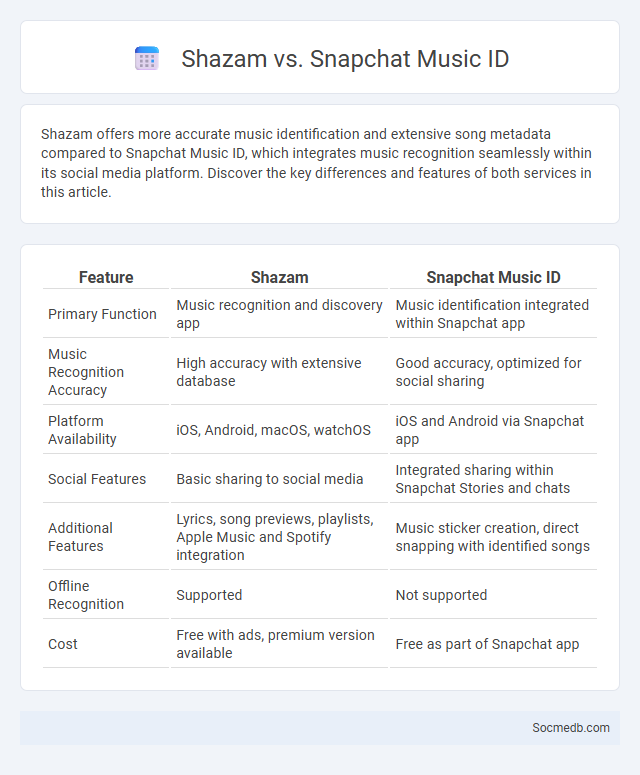
Photo illustration: Shazam vs Snapchat Music ID
Shazam offers more accurate music identification and extensive song metadata compared to Snapchat Music ID, which integrates music recognition seamlessly within its social media platform. Discover the key differences and features of both services in this article.
Table of Comparison
| Feature | Shazam | Snapchat Music ID |
|---|---|---|
| Primary Function | Music recognition and discovery app | Music identification integrated within Snapchat app |
| Music Recognition Accuracy | High accuracy with extensive database | Good accuracy, optimized for social sharing |
| Platform Availability | iOS, Android, macOS, watchOS | iOS and Android via Snapchat app |
| Social Features | Basic sharing to social media | Integrated sharing within Snapchat Stories and chats |
| Additional Features | Lyrics, song previews, playlists, Apple Music and Spotify integration | Music sticker creation, direct snapping with identified songs |
| Offline Recognition | Supported | Not supported |
| Cost | Free with ads, premium version available | Free as part of Snapchat app |
Introduction to Music Identification Apps
Music identification apps harness advanced audio recognition algorithms to quickly analyze and match sound snippets to vast music databases. These apps utilize machine learning and cloud computing to provide accurate song titles, artists, and album details in seconds. By integrating with social media platforms, users can easily share their musical discoveries and connect with communities based on listening preferences.
Overview of Shazam’s Core Features
Shazam's core features enable you to instantly identify songs playing around you by capturing audio through your device's microphone. The app provides detailed information including artist name, lyrics, music videos, and streaming links, enhancing your music discovery experience. Seamless integration with platforms like Apple Music and Spotify allows quick access to playlists and song sharing.
Snapchat’s Music ID Functionality Explained
Snapchat's Music ID functionality enables users to identify songs playing around them by simply pressing and holding on the camera screen, similar to Shazam integration. This feature leverages audio recognition technology to provide instant artist and track details within the app, enhancing user engagement and content sharing. Users can directly add identified tracks to their Snap stories or explore them further on music streaming platforms, seamlessly blending social interaction with music discovery.
What is Shazam Integration?
Shazam integration refers to the seamless incorporation of the Shazam music recognition technology within social media platforms, enabling users to identify songs directly from posts or videos. This feature enhances user engagement by allowing instant access to song details, artist information, and streaming options without leaving the app. Popular social networks like Instagram and Snapchat utilize Shazam integration to enrich multimedia content and facilitate music discovery.
User Experience: Shazam vs Snapchat Music ID
Shazam offers a streamlined user experience by instantly identifying songs with a single tap, providing accurate metadata and seamless integration with streaming services like Apple Music and Spotify. Snapchat Music ID enhances social interaction by allowing users to share song discoveries directly within snaps, combining music recognition with social storytelling. Both platforms prioritize quick, intuitive music recognition but differ in their approach to engagement: Shazam focuses on in-depth music identification and discovery, while Snapchat emphasizes social sharing and multimedia integration.
Accuracy and Speed of Music Recognition
Music recognition on social media platforms combines cutting-edge algorithms and vast audio databases to deliver highly accurate results in seconds, enhancing user engagement. Your ability to identify songs instantly supports seamless sharing and interaction within communities. Advanced technologies like AI-driven fingerprinting ensure precise matching even in noisy environments, making speed and accuracy top priorities in music recognition services.
Social Sharing and Community Features
Social sharing on social media enables you to easily distribute content across multiple platforms, amplifying reach and engagement while fostering authentic connections. Community features like groups, forums, and interactive events create spaces where users collaborate, exchange ideas, and build genuine relationships. Leveraging these tools enhances your social presence, driving brand loyalty and increasing organic visibility.
Privacy and Data Concerns
Social media platforms collect extensive personal information, making your privacy vulnerable to data breaches and unauthorized access. Understanding how platforms use your data for targeted advertising or sharing with third parties is essential to control your digital footprint. Implementing strong privacy settings and regularly reviewing permissions can help protect your personal information from misuse.
Platform Compatibility and Accessibility
Ensuring platform compatibility across Android, iOS, and web browsers maximizes your social media reach and user engagement. Accessibility features like screen readers, closed captions, and voice commands enhance usability for people with disabilities, broadening your audience. Prioritizing these elements helps your content perform seamlessly on various devices and supports inclusive interaction.
Final Comparison: Which Music ID Tool Wins?
The Final Comparison of music ID tools highlights Shazam's unmatched accuracy and extensive song database, outperforming competitors like SoundHound and Musixmatch in identifying obscure tracks. Shazam's seamless integration with platforms such as Apple Music and Spotify enhances user experience by providing instant access to full songs and playlists. For social media users seeking rapid song recognition and sharing capabilities, Shazam consistently delivers superior performance and reliability.
 socmedb.com
socmedb.com